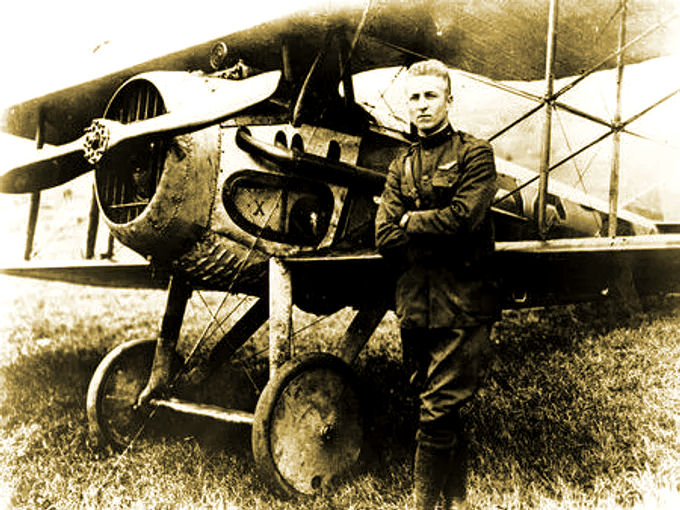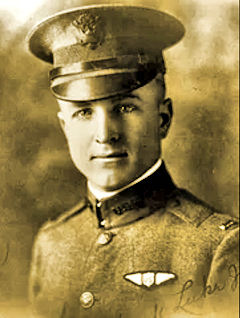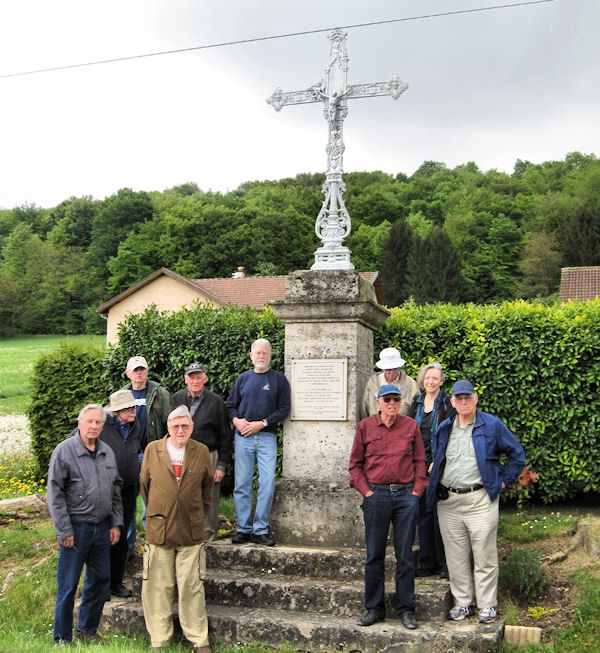Frank Luke, The Balloon Buster
From the Aviation Hall of Fame

Frank Luke with His Spad XIII
The death of Frank Luke was a mystery until after the Armistice ended World War I. When Luke did not return from his mission on Sept. 29th, 1918, numerous fantastic legends sprung up about his fate, most of them incredible and definitely untrue. One little-known fact was that he was very religious and every Sunday he would go to Mass. There, he and Joe Broz would pour into the collection plate of the little nearby French church their entire winnings from the previous night’s crap game.
He earned his wings in 1917 at Rockwell Field, California.
During a seven-day period, Sept. 12-18th, 1918, two days of which he did not fly, he scored 13 confirmed victories, including an amazing five victories (two balloons and three airplanes) on the last day.
They called him the “Sausage Buster,” and “the Arizona Balloon Buster”.
Altogether Luke shot down 14 enemy balloons and four airplanes.
He was killed near Murvaux, France by enemy soldiers when he refused to surrender and tried to hold them off with a pistol.
He received, posthumously, the Congressional Medal of Honor.
Captain Eddie Rickenbacker said of Luke: “He was the most daring aviator and greatest fighter pilot of the entire war. His life is one of the brightest glories of our Air Service. He went on a rampage and shot down fourteen enemy aircraft, including ten balloons, in eight days. No other Ace: Britain’s Bishop from Canada, France’s Fonck or even the dreaded Richthofen had ever come close to that.”
Luke was, indeed, one of the most remarkable men to serve his country. He was a giant in developing the skills for aerial combat, and left a legacy still unmatched today. His attributes included the requisite qualities of a fighter pilot: exceptional courage, the ability to think and act quickly, skill, and creativity in the air. His exploits had a direct effect upon the development of American air tactics and he stands tall in all history as an unforgettable example of true valor and self sacrifice.
Frank Luke, Jr. was born in Phoenix, Arizona, on May 19th, 1887. His story began when his father, Frank Luke, Sr., came to the sun-scorched, wind-weathered desert of the Arizona Territory in 1873. Born of sturdy German stock, he had originally immigrated to New York, but his restless, adventurous spirit soon brought him westward. He eventually married Tillie Lubenow and settled in the area that is now the city of Phoenix. There they raised a family of nine children, including Frank, Jr., the eldest son.
Frank Luke, Jr.’s spirit reflected that of his pioneering father. He grew up in the rough and tumble life of the Old West. He understood that the price that Man paid for conformity was individual freedom and freedom was something he clearly understood. He spent much of his time in the saddle. He loved to hunt and was an excellent marksman. Trailing a packhorse, he would leave Phoenix for days with his carbine at his side and spend his time in the silent desert and peaceful mountains of Arizona. After he enrolled in the Phoenix Union High School, Luke gained a reputation for action. A superb athlete, he went out for sports and is said to have at one time broken a collarbone during an important football game. But he refused to leave the field before the game was finished. Young Luke worked briefly in a mine. In fact, he learned about America’s entry into World War I when he rode into the mining town of Globe, Arizona, after five days on the trail. In the days that followed, he thought about enlisting. The Aviation Section of the Signal Corps drew him like a magnet, for those who flew were true adventurers. Besides, the freedom of flight suited his individualistic temperament, a temperament born of men who had carved a home and a living out of the Southwestern frontier. He was of the breed of strong, brave men who played lone hands and who placed a premium on individual resourcefulness and self-initiative.
In 1917, after the United States entered World War I against Germany, twenty-year old Frank Luke, Jr. of Phoenix, Arizona, enlisted in the Aviation Section, earned his wings and sailed for France. There his first assignment was to America’s famed 27th Aero Squadron in July 1918, and its commander told him that he could become an “Ace.” But a trip to the Front left a profound impression on Luke, as he saw scores of wrecked planes and pilots killed in dogfights with bullets in their backs. “They’ll never get me that way!” he vowed. Then he watched in fascination as a German plane shot down an American observation balloon. At that moment he seemed to set out to become America’s greatest balloon strafer.
August 18th: Luke engaged in his first aerial combat. Long after the squadron returned, he landed his bullet-riddled Spad and declared: “I’ve got a Fokker!” But his squadron mates doubted his claim. Only First Lieutenant Joseph Wehner believed him and they became inseparable friends. At this point Luke developed a daring plan for shooting down enemy balloons, in which he must scorn terrifying antiaircraft fire, ignore enemy planes and attack without thought to his own safety.
September 12th: The great St. Mihiel offensive began and Luke stated: “I’m going after the balloons!” Wehner flew cover, while Luke dove and fired at his first balloon over Marieville. On his third pass, the balloon finally burst into flames. But his Spad took severe damage from anti-aircraft fire.

Luke with His Newly Won Wings
|
style="border-color: black"
September 13th: A new plane was readied for Luke, equipped with special incendiary machine-guns. His mechanics worried when they saw a pistol strapped in his cockpit. He tells them: “I never will be taken prisoner!” That same day Luke proposed an even more daring plan to down enemy balloons, by attacking at dusk when antiaircraft fire was less accurate and the German planes protecting the balloons had retired for the day. He and Wehner were to act as a team, one to fly cover while the other attacked.
September 14th: Luke put his tactical invention to use when General Billy Mitchell called for the downing of two balloons in a few hours. On the morning patrol, Luke dove at a balloon near Boinville. But he had to ignore repeated antiaircraft hits before the balloon went down on the sixth pass. On the afternoon patrol, Luke and Wehner struck at the balloon near Buzy. When they dove, Luke’s first bullets hit their mark and the balloon exploded. They soon spotted another balloon but enemy Fokkers halted their attack. In the melee, Luke’s guns jammed and, as he dove for safety, their bullets riddled his Spad. Minutes later, he landed and begged for another plane to go after more balloons. But his commanding officer refused, saying: “I’m proud of you, Frank. You have just done the impossible!” Later, Billy Mitchell arrived to add his congratulations and to hear Luke’s plan for strafing balloons at dusk. Luke informed Billy: “If you return tomorrow evening, you’ll see two more balloons burn up!”
September 15th: in the morning Luke sent two balloons near Boinville to the ground in flames. But when Mitchell arrived to witness Luke and Wehner down two balloons at a promised 6:58 P.M., he said: “It’s impossible!” To down a balloon at all was a feat. All of a sudden there was a huge explosion in the sky near Spincourt. Moments later, Mitchell yelled: “My God! There goes the other!” Luke had destroyed both balloons. When he and Wehner landed, they received congratulations from Mitchell and other officers. “We’ll burn them as fast as they put them up!” Luke promised.
September 16th: When orders were issued to strafe three balloons hanging beyond St. Mihiel, Luke said: “The first one will go up in flames at exactly 7:05.” Few believed they could reach the balloons, but at exactly 7:05 Luke and Wehner dove and fired at a balloon near Reville. “There goes the first one!,” somebody shouted. Then they turned toward Romagne and almost to the second, at 7:21, a gigantic burst appeared. Luke had downed the second balloon. Finally, at 7:35, the sky erupted for the third time, as Wehner downed another balloon. As for Luke, his record stood at an incredible nine balloons.
September 18th: Luke and Wehner took off to attack balloons east of Verdun. It would prove to be their last flight together, as Luke dove three times to down a balloon near Labeuville. Suddenly, six Fokkers bore down on Luke. With great daring, he raced toward a second balloon, before they could intercept him, and sent the balloon down in towering flames. Then Luke caught sight of Wehner’s plane falling earthward in flames. Luke’s best friend had been shot down while trying to protect him, a courageous act of self-sacrifice! Consumed with fury, Luke turned on Wehner’s attackers and in less than ten seconds shot down two of them! Then, as he flew toward Verdun, he spotted a German observation plane. Roaring down out of the sky, he opened fire and the enemy plane fell off in a spin and crashed. Frank Luke had shot down two balloons and three planes in less than ten minutes, an incredible feat never to be equaled in the history of warfare!
September 19th: The First Pursuit Group held a dinner in Luke’s honor. At this point, he now had fourteen officially confirmed victories, surpassing Eddie Rickenbacker and was hailed as America’s new “Ace of Aces.” Later Rickenbacker would write: “There never has been an aviator who possessed the confidence, ability and courage that Frank Luke had shown during those remarkable two weeks.” But the loss of Wehner and the fatigue of battle were taking their toll on Luke. He grew morbid and silent and finally received a seven day rest leave.
September 26th: When the Allies launched their massive Argonne-Meuse offensive, Luke’s commanding officer told him: “I’ll give you enough protection to run your string to a hundred. Only be careful!” “Don’t worry,” replied Luke, “They can’t get me!”. That day Luke bagged another Fokker.
September 27th: Luke teamed up with Lieutenants Ivan Roberts and Alden Sherry to strafe balloons. Instead, they ran into five Fokkers. In the bitter dogfight that ensued, Luke got an unconfirmed victory, but Roberts was never seen again and Sherry was shot down near the American lines. That night, after Luke got another unconfirmed balloon victory, he deliberately spent the night at the Toul airdrome, where the French treated him like a king. But his commanding officer considered him “absent without leave.”
September 28th: When Luke returned to his own airdrome the next morning, his commander severely reprimanded him. Angered and upset, he took off without permission and headed for an enemy balloon near Bethenville. By this point Luke seemed to believe that he was invincible. In the last combat report he ever made, Luke writes: “I flew north to Verdun and found a balloon in its nest near Bethenville. Later that day, he took off again, without authorization, and spent the night again with the French squadron.

Frank Luke Memorial at Murvaux Overlooking the Site of His Crash and Last Battle
September 29th: Soon after Luke’s commanding officer grounded him, Luke took off and headed for three balloons near Dun-Sur-Meuse. As he flew low over the American balloon headquarters, he dropped a message that read: “Watch three Hun balloons over the Meuse. Luke.” Minutes later a red glow filled the sky. Luke had downed the first balloon. What happened to Frank Luke after that is still unknown. But he would never return from this mission. Historians will always view with a degree of mystery the fate of Frank Luke, Jr. Not until 1919 did authorities locate his unmarked grave near the village of Murvaux, France. From an affidavit that the village residents signed, it appears that enemy Fokkers jumped Luke. He shot down two before being severely wounded in the shoulder. Eluding his attackers, Luke downed two more balloons. But his Spad began losing altitude. When he reached Murvaux, he swooped down and strafed troops in the streets, killing six and wounding many more. Then he made a forced landing, crawled out and headed for a nearby stream, apparently to get water to treat his wound. But German infantrymen intercepted him and ordered him to surrender. Frank Luke, Jr. could have honorably surrendered and become a prisoner. Instead, he drew his pistol and fired at the infantrymen, killing seven before he went down with a great wound in his chest. The enemy had killed Frank Luke, Jr. That was the most they could do, for they could not defeat him in the air.
Frank Luke, Jr., the “Arizona Balloon Buster,” was one of the bravest men ever to wear the wings of the Aviation Section. He possessed a unique combination of shyness and aggression, plus an honest dislike for excessive discipline. But not one ever questioned his courage in the air as his career increased in brilliance. In any other branch of service, he would have been unhappy. In the Aviation Section he found expression in the freedom of flight.
|